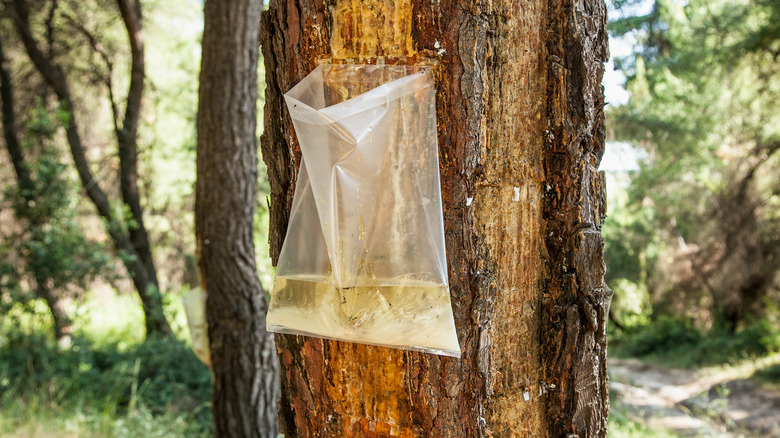Retsina Is The Traditional Greek Wine Made From Pine Resin
Retsina can be a divisive Greek wine. Made from pine needles, the libation wasn't always respected in wine circles, has been mixed with Coca-Cola, and is often cheaply sold. Some have even argued that retsina doesn't classify as wine but as something closer to vermouth. Others insist that "retsina" is a term encompassing a particular way of making wine — adding pine resin during the fermentation process — and not the wine itself. One thing that is certain is that this drink as a long history within Greek culture.
The traditional recipe for making retsina dates back thousands of years. Many years ago, Greeks kept wine in amphorae, which are clay vessels that have now found homes in museums. To protect wine from unnecessary exposure to air, Aleppo pine resin plugs were used, and retsina — originally called retinitis oenos – was made with pine resin to preserve the alcohol. In Central Greece, vineyards were located near pine forests, and the trees offered the perfect ingredient to seal and coat the ceramic vessels used to store wine. Once dried, the sticky substance could eliminate potential exposure to air, and syrup taken from pine trees made for a convenient sealant.
Later, wine barrels were made of pine, and pine resin was also used to bulk up weaker wines and build aromatic profiles. While the resinous aspect can give some wine connoisseurs pause, many winemakers are embracing retsina and attempting to elevate the perception of this traditional wine. The piney white wine has drawn both critics and fans, with some describing the taste as crisp and lemony while others are quick to point out unpleasant notes of turpentine and forest.
Many ways to enjoy this piney wine
Many retsinas are made with the sturdy and ancient Savatiano grapes, which are still one of Greece's most common varieties. Retsina is a dry wine that often has a mineral finish, and aromas can carry fruit and floral notes. It can be both white and rosé, but white is more common. Tasting notes can vary according to region, and retsina's flavor is often complementary to traditional Greek cuisine. Delectable mezedes — Greek appetizers — and the flavors of fish and cheese aren't muted when served with cold retsina, and the resinous wine can easily accompany many traditional Greek dishes.
Retsina can be served with fresh seafood and other meats as well as flavorful, herby, and garlicky recipes. From dolmades to fried sardines and anchovies, or even pungent cheeses, retsina can hold its own. It's an affordable wine, and some drinkers use it to make spritzers. Bottles of retsina can be found with screwtop caps, corks, or plastic stoppers. Admittedly, the hint of pine resin in its flavor and aroma isn't for everyone. But proponents of the wine tote its many attributes: vanilla and peach notes, a balanced palate of acidity and spice, and flavors that play well with popular dishes such as Greek salad.

